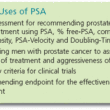The Back Story of PSA Testing
Screening for prostate cancer is controversial, but it shouldn’t be. In the U.S., prostate cancer is the most common non-skin cancer and  the second-leading cause of cancer death in men, with an estimated 313,780 new cases being diagnosed in 2025, and 35,770 projected prostate cancer deaths. Prostate cancer seldom produces symptoms until it is incurable; therefore, with no known means of preventing prostate cancer or of curing advanced-stage disease, the main hope for reducing suffering and death from prostate cancer is through early detection and appropriate and effective patient management.
the second-leading cause of cancer death in men, with an estimated 313,780 new cases being diagnosed in 2025, and 35,770 projected prostate cancer deaths. Prostate cancer seldom produces symptoms until it is incurable; therefore, with no known means of preventing prostate cancer or of curing advanced-stage disease, the main hope for reducing suffering and death from prostate cancer is through early detection and appropriate and effective patient management.
The Early PSA Screening Era (1991-2008)
Before there was PSA screening, the only methods of diagnosing prostate cancer early were digital (finger) rectal examination (DRE) or finding cancer in tissues removed at surgery for presumed benign prostatic enlargement (BPH). Consequently, before the PSA screening era, most patients were diagnosed with an incurable disease. For those who did not die of other causes within 15 years, many ultimately died from prostate cancer.
PSA as the First-Line Screening Test for Prostate Cancer
All prostate cancer patients experience a change-point in the PSA growth rate that normal patients do not experience. PSA increases by an estimated 2% per year before the change- point. After the change-point, PSA increases by 15% per year for patients with localized prostate cancer and by 63% for patients with metastatic disease. Most prostate cancer patients experience this transition at levels of PSA lower than the frequently suggested 4.0 ng/mL for considering a prostate MRI scan or biopsy.
PSA exists in several forms that can be measured in a blood sample. The relative proportions of these PSA forms are helpful in distinguishing between high PSA blood levels caused by benign conditions such as inflammation or BPH and those caused by prostate cancer. They also reflect the aggressiveness of prostate cancer.
In 1986, the U.S. Food and Drug Administration (FDA) approved PSA formonitoring the course of prostate cancer in patients. In 1991, Dr. Catalona’s research team demonstrated the utility of PSA as a first-line screening test for prostate cancer. The likelihood of aprostate cancer diagnosis increases with increasing PSA levels. However, some rare prostate cancers do not produce muchPSA. After Dr. Catalona’s initial report in The New England Journal of Medicine, PSA testing received widespread adoption. Dr. Catalona led the pivotal study that led to FDA approval of the PSA test in selectingpatients for prostate biopsy. In 1992, theAmerican Cancer Society began recommending PSA and DRE screenings for men aged 50 and older; their updatesinclude recommending earlier screening (starting at age 45) for high-risk groups.
Randomized Clinical Trials of PSA Screening
U.S. and European researchers launched two large randomized clinical trials (RCTs) to rigorously evaluate PSA screening. The European Randomized Study of Screening for Prostate Cancer (ERSPC) enrolled a predefined core age group of more than 160,000 men (aged 55–69 years). After a median follow-up of 16 years, it reported that there was a 20% lower prostate cancer death rate in thescreening arm. In contrast, the U.S.Prostate, Lung, Colorectal, and Ovarian Cancer Screening Trial (PLCO) of more than 38,000 men after a median follow-up of 15 years reported no overall prostate cancer mortality advantage from PSAscreening. However, the PLCO trial is non-informative on the benefits of screening versus no screening, because it was later revealed that nearly 90% ofPLCO controls in the “non-screening arm” had PSA testing before or during the trial.
Epidemiologic Impact of PSA Screening in the Early PSA Screening Era (1991-2008)
With the advent of widespread PSA testing, there was a dramatic stage migration from most patients being diagnosed with incurable prostate cancer to most being diagnosed with curable disease. In the U.S., the prostate cancer mortality rate decreased by more than53% during the PSA screening era, primarily due to an 80% lower rate of patients with metastases at diagnosis.
The Politics of PSA Testing and the Emergence of the “PSA Dark Ages” (2008-2017)

Screening for prostate cancer has been challenged because of concerns about the risk of triggering unnecessary biopsies and the over-diagnosis and over- treatment of indolent tumors with possible untoward side effects. The United States Preventive Services Task Force (USPSTF) is ” …an independentpanel of experts in primary care and prevention that systematically reviews the evidence of effectiveness and develops recommendations for clinical preventive services”.
Their mission is to make recommendations for primary care physicians. Ironically, the USPSTF panel for early prostate cancer detection comprised internists, pediatricians, family physicians, obstetricians, gynecologists, and nurses. However, there were no urologists, radiation oncologists, or medical oncologists who treat patients with prostate cancer in routine clinical practice. The USPSTF can select the studies it deems most relevant to review and typically gives randomized trials the most weight.
In 2008, the USPSTF first recommended against screening (Grade D recommendation) in men over 75, mainly based on their limited life expectancy and the lack of compelling data on the benefits of screening in this age group. However, PSA screening in men over 75 has never been adequately tested in RCTs. Therefore, robust data to support this grade D recommendation is lacking.
The Conflicting Trial Results (2009-2016)
One year later (2009), the conflicting results from the ERSPC and PLCO trials were simultaneously published in the same issue of the New England Journal of Medicine. Shortly thereafter, the Task Force began a new evidence review one year ahead of schedule. After completing this early review in 2012, the Task Force issued a grade D recommendation against screening for all men, concluding thatthe harms outweigh the benefits. This Draconian ban was shocking to many. The American Urological Association(AUA) was “…outraged…” that the TaskForce was doing men a great disserviceby disparaging the only widely available test for early prostate cancer detection.
The “PSA Dark Ages” (2008-2017)
In the aftermath of the USPSTF’s 2008 and 2012 grade D recommendations against PSA screening, testing rapidly decreased by 25-30% in the U.S., significantly reducing the overall prostate cancer incidence rates and precluding early prostate cancer detection in many patients. Beginning with the 2008 recommendation against screening in men over 75 years of age, a reversal of the favorable tumor stage migration occurred. Since 2011, among men aged 75 or older, there has been a significant increase in the proportion ofmen, like former President Biden, presenting with metastases at the time of diagnosis and a similar trend in younger men. The National Cancer Institute (NCI) statistical network projected that if screening were completely phased out in 2012, as recommended by the TaskForce, the number of cases of metastatic disease would return to the pre-PSA screening era levels by the year 2025.
Criticisms of the USPSTF Analysis
USPSTF’s analysis has been extensively criticized. Even USPSTF’s former chair, Dr. Harold Sox, pushed back, stating,“Guidelines should avoid recommending for or against PSA screening. Rather. we should recommend a shared decision process that includes assessing patients’ feelings about what they could go through after screening.” The most crucial criticism ofthe USPSTF methodology was its heavy weighting of PLCO, which incorrectly reported about a 50% rate of PSA testing in the control arm in their initial PLCO report.

The Independent Re-evaluation of PLCO Trial Data (2016)
In 2016, Shoag et al reported on an independent evaluation of the PLCO data indicating that the proportion of control participants who reported having undergone at least one PSA test before or Shoag’s independent review, guideline during the trial was close to 90%. Before Shoag’s independent review, guideline panels, when formulating policy recommendations, had not recognized or cited the extremely high screening rate in the control arm of PLCO. Shoag et al concluded that the high rate of PSA testing in the control group presented a severe limitation, and that millions of men had not been offered PSA screening because of a lack of knowledge of this shortcoming.
The Independent Re-analysis of ERSPC and PLCO Trial Data (2017)
In an independent analysis of PSA screening benefits on the earlier detection of prostate cancer resulting from screening, Tsodikov et al reported that the mortality benefit in ERSPC was 25-31% compared to 27-32% in PLCO. Thus, both large RCTs ultimately demonstrated that PSA screening produced a significant mortality benefit of more than 25%.
USPSTF Upgrades Grade D to Grade C with Shared Decision-Making (2017)
In 2017, the USPSTF pivoted and issued a draft recommendation for “shared decision-making, ” in which clinicians inform men aged 55 to 69 years about the potential benefits and harms of PSA screening. However, the new USPSTF recommendation maintainsthe grade D recommendation for men younger than 55 and older than 69, age groups that have not been adequately tested in RCTs to justify a recommendation for or against early detection. Thus, the new draft recommendation excludes baseline screening in men in their 40s and early
50s for assessment of their future risk for metastatic or lethal prostate cancer. The Task Force’s current draft recommendation also lacks special consideration of high-risk men, such as men with a family history of prostate cancer or Black men, for whom there is compelling evidence of greater risk for prostate cancer morbidity and mortality, and thus potentially greater screening benefits.
The Task Force’s stated reasons for changing its grade D to grade C in men aged 55-69 years old were based in part on additional evidence that increased certainty about the reductions in risk of metastatic disease and death from prostate cancer. Another main reason was the increased use of active surveillance of low-risk patients.
The PSA Screening Controversy Persists
The controversy over PSA testing has persisted despite unequivocal evidence that PSA testing saves lives. Although USPSTF’s current recommendation is a step in the right direction, more progress is needed. Men should be informed that baseline PSA testing in their 40s and early 50s is the best way to assess their risk for subsequent life-threatening prostate cancer, as those in the top tenth percentile of PSA levels for their age group account for almost half of all prostate cancer deaths up to 30 years later. Those with levels above 1.0 ng/mL clearly warrant more careful monitoring. Healthy men in their 70s should not be discouraged from being tested if their life expectancy exceeds 10 years. As life expectancy at age 70 in the U.S. is more than 15 years, some older men will benefit from early detection and treatment of a potentially aggressive tumor.
Unfortunately, the USPSTF’s 2008 and 2012 recommendations have created a generation of primary care physicians who reject PSA testing. Intelligent application of PSA testing will substantially reduce suffering and death from prostate cancer.
A Deeper Dive into Current Prostate Cancer Screening Guidelines

There remain discordances among current guidelines. In 2023-2024, theAUA recommended offering PSA testing
from age 45 for average-risk men, with the option to be tested at ages 50–69. For higher-risk men (e.g., family history, Black ancestry, carriers of high-risk genetic variants) screening can start at age 40–45. In the AUA/SUO (Society of Urologic Oncology) guidelines, screening is generally not recommended for men over 70, particularly those with a life expectancy of less than 10 years. However, clinicians may personalize the re-screening interval or discontinue screening based on patient preference, age, PSA, prostate cancer risk, genomics, overall health, and life expectancy following shared decision-making.
In the 2025 National Comprehensive Cancer Center Network (NCCN) Prostate Cancer Early Detection Guidelines, which were developed for primary care physicians, screening is recommended at age 45-75 for average- risk men, and 40-75 for high-risk men (Black, high-risk pathogenic germline mutation carriers, or a concerning family or personal history of cancer). Importantly, screening can be considered for men over age 75 for “select” patients.
Current Outlook for PSA Testing
Experts predict increased PSA use with refined tools (e.g., biomarkers, MRI), particularly following high-profile cases like President
Biden’s cancer diagnosis.
Med Clin North Am 2018; 102:199-214
N Engl J Med. 1991;324(17):1156-1161
N Engl J Med. 2009;360(13):1320-1328
N Engl J Med. 2009;360(13):1310-1319
N Engl J Med. 2012;367(7):669-671
N Engl J Med. 2016;374(18):1795-1796.
Ann Intern Med 2017; 167:449-455.
JAMA. 1998;279(19):1542-1547
Cancer. 2012;118(23):5768-5776


















